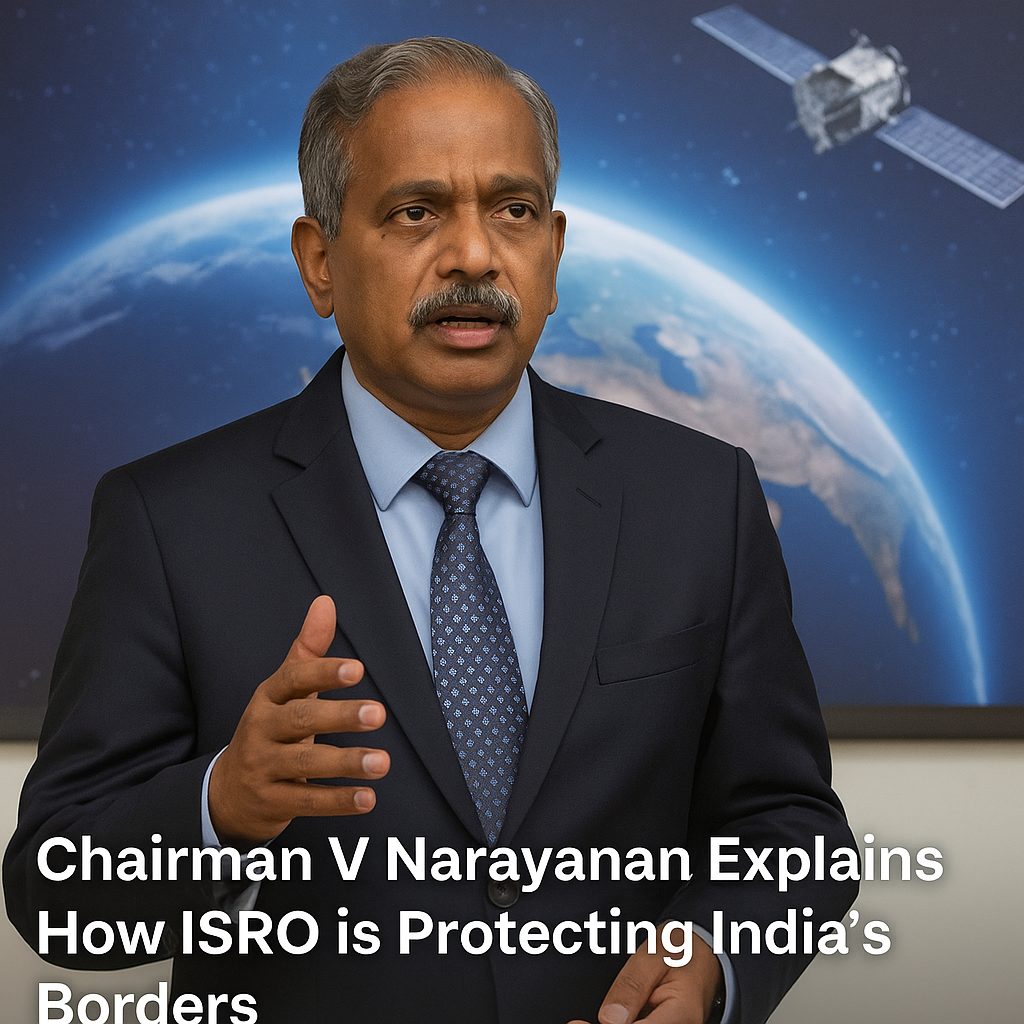In light of the recent attacks and growing tensions with Pakistan, the Indian Space Research Organisation (ISRO) has played a vital role in protecting India’s borders. After a tragic terrorist attack in Jammu and Kashmir’s Pahalgam, where 26 innocent tourists were killed, the Chairman of ISRO, V Narayanan, revealed how the country’s satellite network is continuously safeguarding the nation’s security.
Satellites Guarding the Nation’s Safety
Narayanan emphasized that, to ensure the safety of citizens, ISRO has deployed a significant satellite fleet that is constantly monitoring India’s borders. These satellites support defense and surveillance efforts by tracking possible threats and supplying real-time data. The use of satellite technology is crucial, as it offers the ability to watch over areas that are otherwise difficult to access.
As per Narayanan’s statement, “At least 10 satellites are working round-the-clock for strategic purposes to ensure the safety and security of the citizens of the country.” This statement sheds light on the level of commitment that ISRO has towards national security, as it ensures that the nation remains vigilant, particularly in areas that are prone to border tensions.
India shares a long border with Pakistan, which extends across land and sea. To monitor this vast stretch of land, including the entire Northern region and approximately 7,000 km of coastline, India relies heavily on satellite technology. It would be practically difficult to efficiently monitor such a large and varied region without the use of satellites and drones, according to Narayanan.
Switzerland Steps In as Tensions Mount Over Militarization of Space
India’s Fleet of Surveillance Satellites
ISRO’s satellite capabilities go beyond regular communication and weather satellites. India has developed a specialized fleet of surveillance satellites to monitor its borders. With 22 in low Earth orbit (LEO) and 29 in geosynchronous Earth orbit (GEO), the organization has launched 127 Indian satellites. These satellites provide various services, including real-time surveillance of India’s borders, coastline, and critical infrastructure.
A key element of India’s border surveillance strategy is ISRO’s fleet of spy or reconnaissance satellites. These satellites, which include the Cartosat and RISAT series, are designed to monitor specific areas and gather intelligence. For instance, ISRO’s Cartosat series offers high-resolution pictures that are helpful for monitoring and mapping. The RISAT series, on the other hand, uses radar technology to capture images of the ground regardless of weather conditions or time of day, making it especially useful for monitoring the borders in regions with difficult terrain or poor visibility.
ISRO has also launched smaller satellites, such as the MicroSat and EMISAT series, each of which is intended for a specific surveillance function. These satellites help in tracking potential threats, such as movements of enemy forces, vehicles, or even unidentified aircraft, making them a valuable tool for India’s defense strategy. ISRO’s continuous operation of these satellites ensures that the country remains aware of any changes in the environment, whether in the air or on the ground.
Russia Launches Trio of Satellites—Then a Strange Object Appears From Nowhere
Operation Sindoor: A Strategic Retaliation
In the aftermath of the Pahalgam attack, India took immediate action to strike back against terrorist camps in Pakistan and Pakistan-occupied Kashmir (PoK). Within two weeks, India executed a calculated and precise military operation, dubbed ‘Operation Sindoor,’ which targeted terrorist hubs. The operation was named in honor of the women who lost their loved ones in the attack, showing the deep emotional connection behind the strategic strike.
The operation aimed solely at eliminating terrorist targets, ensuring that no civilians or military installations were harmed. India used its surveillance satellites to identify these terrorist camps with great accuracy. By leveraging satellite images, India was able to carry out well-coordinated strikes, targeting terror camps across nine locations, which resulted in the deaths of hundreds of high-profile terrorists.
In contrast, Pakistan’s attempts to retaliate involved targeting civilian areas, holy sites, and airbases, actions that caused significant harm to innocent lives. India, however, demonstrated a more strategic and calculated approach, focusing on military and terror-related targets.
India’s response was swift and precise, preventing further escalation. Using its satellite data, the Indian defense forces were able to intercept and foil Pakistan’s attempts, ensuring that no major damage occurred to the country’s infrastructure. The retaliation included striking crucial airbases in Pakistan, including Nur Khan, Sukkur, and Rafiqui, among others.
By using satellite technology to monitor and assess the situation, India was able to neutralize the threat without risking unnecessary loss of life or causing widespread damage. This strategic use of space technology not only served a tactical purpose but also underscored the growing importance of satellites in modern warfare and defense.
In conclusion, ISRO’s role in safeguarding India’s borders cannot be overstated. Through its vast array of surveillance satellites, India is able to maintain constant vigilance over its borders, protect its citizens, and ensure national security. The precision of these satellites during Operation Sindoor highlighted the immense capabilities of ISRO in supporting India’s defense efforts, demonstrating that technology can be a powerful tool in the fight against terrorism and threats to national security.




